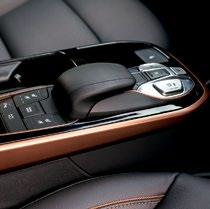Hyundai Ioniq Electric.


Hyundai Ioniq Electric.

“Is this thing running?”, I said as I pushed the start engine button. The status indicators showed that the car was running but there was no noise to be heard or vibration to be felt. And then I remembered the car I was in was the Hyundai Ioniq Electric, one of the few full electric cars on sale in Singapore. By full electric, I mean this car only has batteries and an electric motor. There’s no petrol-powered range extender that kicks in when you run out juice.
From the outside, the Ioniq Electric looks just like the Ioniq Hybrid I tested about a year ago. The only telltale sign is the smooth and permanently closed off front grille since there’s no need for air intakes. Otherwise, the two look identical.
It is much the same story on the inside. The cabin is immediately familiar to me and the biggest changes are the infotainment display (it is larger) and the center console (more space for keeping stuff).
The touch-enabled infotainment display is now a more respectable 8-inches in size. The Ioniq Hybrid had a tiny 5-inch display, which looked out of place and was hard to read. Missing from the center console is a traditional gear lever and selector. In its place are buttons for the usual PRND driving modes. Simply select your desired mode and off you go.
The Ioniq Electric is a markedly different car to drive from the Ioniq Hybrid and any other petrol car, in fact. It is eerily quiet at typical cruising speeds. The electric motor only makes a faint whining noise if you are pushing it hard. It is appreciably quieter than other cars in its class. That said, it isn’t dead silent since there is a fair amount of wind and road noise especially at higher speeds.

And because it uses an electric motor, it has significantly more torque than any other petrol-powered rival. The end result is that the Ioniq Electric is surprisingly nippy. The sprint to 100km/h takes just under 10 seconds and because maximum torque is available almost instantly, there is a sense of immediacy that you just don’t get from any other family car.
However, the most different thing about driving the Ioniq Electric is coming to terms with its regenerative braking. The Ioniq Electric recovers energy whenever you take your foot off the accelerator and users can choose from four levels. In the lowest setting, the car is free to coast and this is recommended for highway driving. On the highest setting, the car brakes quite aggressively whenever you lift your foot off the gas to recover as much energy as possible. This is recommended for driving in heavy city traffic. Obviously, managing and getting used to the regenerative braking is paramount if you want to get the maximum range out of the car.
Hyundai claims a maximum range of 280km with the Ioniq Electric. With my heavy right foot, I managed an efficiency of 8km/kWh, which translates to a range of around 224km since the Ioniq Electric’s total battery capacity is 28kWh. Even though this down from its official claim of 280km, it is still more than enough for the average driver in Singapore and will allow drivers to cover the length of Singapore more than four times over. For owners who charge their Ioniq Electric daily, range anxiety shouldn’t be an issue. Speaking of which, the Ioniq Electric will come with a wall box charger, which owners can install in their homes and will charge the car from zero to 100% in about 4.5 hours.
However, if access to a charger is a problem. You might want to reconsider about getting the Ioniq Electric or any other electric car for that matter. As of now, public charging spots are sparse and I encountered issues when I was trying to use one during my test, which meant I couldn’t charge at all.
For owners who have unrestricted access to a charger, the Ioniq Electric might make sense. It is comfortable and practical, and though it has a pretty high sticker price, you could end up saving more in the long run especially if you travel quite a bit. Based on the electricity tariffat the time of writing, a full charge will only set you back about $6.20, which, based on my usage, means every 100km costs just $2.76. In other words, the Ioniq Electric will be significantly cheaper to run than any petrol-powered car.

The cabin is well furnished and a comfortable place to be in.

The center console has a built-in Qi wireless charging pad, which means leaving the wired mess at home with modern mobile devices that have wireless charging capabilities.

The instrument panel is made up of a 7-inch TFT LCD display.

CONCLUSION
A super-efficient car but the lack of infrastructure means it is not for everyone.
AT A GLANCE:
ENGINE
Permanent magnet synchronous motor
POWER
88kW (118hp) / 295nm
BATTERY CAPACITY
28kWh
RANGE
Up to 280km
PRICE
$134,888 (inclusive COE)
PICTURES HYUNDAI























